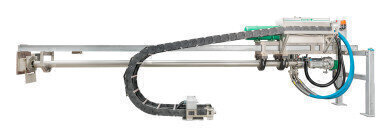Measurement and Testing
Flue gas analysis probe enables permanent process control in cement kilns
Dec 03 2021
Permanent and uninterrupted process control in cement rotary kilns is required to increase clinker quality and output, reduce harmful emissions and to decrease maintenance costs of plant infrastructure / prevent plant downtime.
This can be achieved with the CEMTEC kiln probe system produced by ENOTEC in Germany.
CEMTEC is self-monitoring and self-cleaning which enables uninterrupted flue gas analysis.
The difficulty of the sample gas extraction from cement kilns has long been a common problem for Control and Instrumentation departments and cement plant operators.
The measuring point at the kiln inlet chamber is notoriously difficult because of the challenging conditions of high and sticky dust loading (blocking of probes), corrosive flue gas (corrosion and blocking of heated gas extraction lines) and heterogeneous fuel (increased RDF).
Additionally, the trend of increased use of RDF (Refuse Derived Fuel) causes combustion related challenges as the secondary fuel feed rate needs to be optimally controlled by the measurement data.
Efficient combustion control via monitoring and control of O2, NOx and CO
Main combustion parameters, O2, NOx and CO, need to be monitored and tightly controlled, which among other things enables the production of permanently high clinker quality. Importantly these permanent measurements enable reduction of CO2 emissions and help keep NOx emissions below abatement limits. Additionally NH3 slip can be reduced because of increased efficiency of the SNCR denitrification spraying system - the relationship between NOx in the kiln inlet chamber and ammonia water consumption of the SNCR system are directly connected.
Keeping excess O2 and CO low after combustion from the kiln main burner is the most important objective from a process control point of view:
Low excess O2 automatically results in low NOx production / emissions and a lowered requirement of ammonia input for NOx reduction. Additionally this is an indicator of fuel efficiency.
Low excess CO results in reduced CO2 emissions and is less damaging to plant infrastructure, such as to the refractory lining, causing less downtime of the plant for repairs.
Low O2 and low CO after combustion is thus an indicator of finely-tuned main burner combustion.
On the other hand, high excess O2 after combustion is wasteful and higher CO concentrations are usually the result of an oxygen deficient combustion (lambda < 1). This is the importance of precisely controlling a combustion process which can only be guaranteed by permanent process control.
Prevention of sample probe plugging
Simple measures also have a large impact: By limiting the dust intake into the kiln sample probe, the automatic requirement for purging is decreased. During the purging process, no process measurements are possible so the availability of measured values decreases. Sticky dust deposits within the sample probe often need to be cleaned manually by maintenance staff. This is difficult and dangerous work.
Plugging of the probe entrance is typical for probes without a plunger system and also needs to be manually cleaned in short intervals.
Limiting dust ingress in addition to an effective filter system is key to delivering dust free sample gas to downstream analyzers.
How to avoid your sample probe getting ‘cemented in’
Due to the probe being inserted into the kiln for prolonged periods, most probes on the market are prone to getting stuck in the process due to being “cemented in” at the duct flange where the cement mix / raw meal is stationary and due to being pre-calcined, will start to harden. A stuck probe is prone to bending at some stage and will need to be pulled out with a pulley system if the retraction motors do not have sufficient torque or if other mitigation properties are not available.
Are you looking for a proven solution to gas sampling in industry’s toughest locations?
In over 100 installations worldwide, the German designed and built CEMTEC probe system continues to impress through its ability to self-clean and self-monitor to the extent of being fully autonomous 24/7 and deliver dust-free sample gas to downstream analysers for permanent process control and monitoring.
The internal probe plunger removes deposits from the probe entrance in regular intervals to ensure continuous gas extraction.
The probe rotation motor rotates the probe +/- 45 ° in regular intervals to prevent sticking and bending.
The low dust ingress construction and large surface area internal filter ensures a continuous flow of dust free sample gas.
All powerful motors are pneumatically driven and are as such independent of the plant’s power supply.
The CEMTEC probe system requires only one maintenance cycle per year which coincides well with the plant planned maintenance for repairs to e.g the refractory lining. This ensures highest possible efficiency.
Additionally because of the effect of the CEMTEC to decrease plant wear & tear, the operation time between plant shutdowns can be increased which results in increased clinker output.
Digital Edition
PIN 25.1 Feb/March
March 2024
In This Edition Safety - The technology behind the ION Science Tiger XT - Safety with ammonia and LOHCs as hydrogen carriers Analytical Instrumentation - Discussion on new tribology te...
View all digital editions
Events
Apr 28 2024 Montreal, Quebec, Canada
Apr 30 2024 Birmingham, UK
May 03 2024 Seoul, South Korea
May 05 2024 Seville, Spain
May 06 2024 Riyadh, Saudi Arabia


















